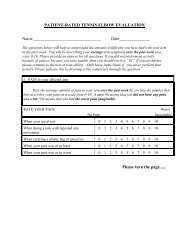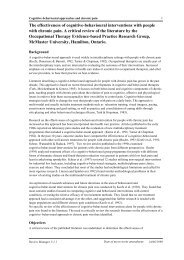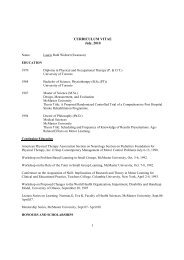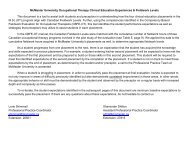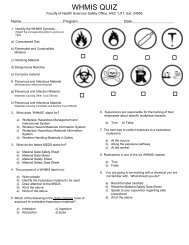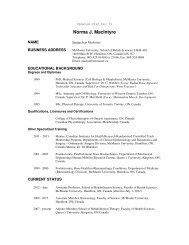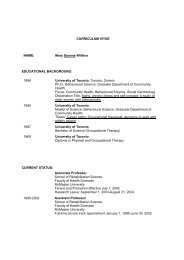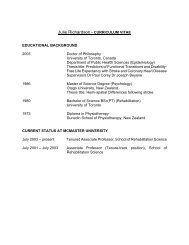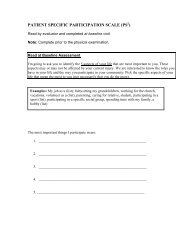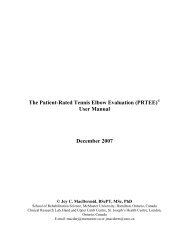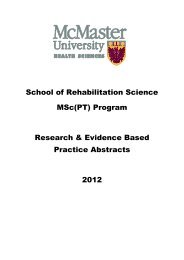Evidence Based Practice Symposium - McMaster University
Evidence Based Practice Symposium - McMaster University
Evidence Based Practice Symposium - McMaster University
You also want an ePaper? Increase the reach of your titles
YUMPU automatically turns print PDFs into web optimized ePapers that Google loves.
Living with mental health issues<br />
Having mental health challenges seemed to add another<br />
dimension of stigma and further contributed to participants<br />
feeling marginalized by society.<br />
Experiencing barriers to employment<br />
Receiving disability supports instead of working or enjoying<br />
retirement seemed to be a frustrating issue for many women.<br />
Some of the participants described that these supports create a<br />
disincentive to obtain employment.<br />
Contrasting perceptions<br />
Looking ahead to the future<br />
Feeling hopeful: Some women spoke of the positive aspects of<br />
aging, such as growing old with their families, retirement, and<br />
travel. Being HIV-positive seemed to inspire a fighting spirit in<br />
some women: “I want to be the oldest bitch before I die” (130).<br />
Feeling stuck and living day by day: Women spoke negatively<br />
of the future with regards to their deteriorating health and being<br />
a burden on others. They expressed a general uncertainty for the<br />
future and had few concrete plans, but instead lived “one day at<br />
a time” (147). In this sense, some women appeared to be ‘stuck’.<br />
Disclosing HIV status<br />
Some women were considerate and deliberate about when, how,<br />
and to whom they disclosed their HIV status, which helped to<br />
form supportive and trusting relationships. Others expressed<br />
being fearful of disclosing and subsequently being judged.<br />
Being mobile physically and in the community<br />
The extent to which women were mobile was a contributing<br />
factor to their overall social and community participation.<br />
Coping with and managing HIV<br />
Feeling well and in control: Some women indicated that they<br />
were feeling well, in spite of their health challenges, and had<br />
learned to accept their limits and be “kinder” to themselves.<br />
Making adjustments to their day-to-day living allowed them to<br />
ascertain a sense of personal control over their lives: “I try to<br />
live my life to make it as good as it can be… so I have to<br />
balance” (136).<br />
Feeling overwhelmed and underserved: Some women expressed<br />
frustrations regarding the many health management<br />
responsibilities they had, such as managing their many<br />
medications and attending medical appointments. They also felt<br />
that the current services available to them did not adequately<br />
address their psychosocial needs: “unfortunately with this<br />
disease is it can cause some pain and there’s not a drug or<br />
anything that you can do to help it” (130).<br />
Caring for others<br />
Some women spoke of caring for others as being a complicating<br />
factor as they aged with HIV, while others spoke of it positively,<br />
saying that their children gave hope and meaning to their lives.<br />
Contextual factors<br />
Experiencing stigma<br />
The women described perceiving stigma related to:<br />
Gender and sexual orientation: The women felt that prevailing<br />
societal beliefs that HIV affects primarily gay men meant that<br />
they were not “in with the in crowd” (128). Gender-based<br />
assumptions limited their ability to obtain support and access<br />
services.<br />
Aging: Participants also conceptualized stigma as it pertains to<br />
older adults with HIV, and indicated how, as older women, their<br />
appearance did not fit with societal expectations regarding how<br />
people with HIV look: “I don’t look like an HIV-positive<br />
person, you know, I’m too old, too grey, whatever. I don’t fit<br />
into anybody’s idea of what it is” (136).<br />
HIV: Many women described being the target of stigmatizing,<br />
discriminatory actions that they attributed to their HIV-positive<br />
status. The source of this discrimination was sometimes<br />
healthcare providers.<br />
Culture: Some of the women described being the target of<br />
stigma or discrimination based on their cultural background, or a<br />
location in which they had previously lived.<br />
Viewing instrumental supports as inadequate<br />
Participants indicated that their social participation was limited<br />
by instrumental supports, such as government-run housing<br />
subsidies and income support programs, which were inadequate.<br />
DISCUSSION AND FUTURE DIRECTIONS<br />
The results of this study elucidate a variety of factors associated<br />
with social engagement and social isolation in women aging<br />
with HIV, as well as several contextual factors that relate to<br />
women’s overall social participation. Given that rehabilitation<br />
focuses on enabling participation, these findings may assist<br />
therapists in identifying challenges to participation with clients<br />
and facilitating the collaborative development of client-centred<br />
goals.<br />
These findings add to the current body of knowledge<br />
regarding social participation in clients with HIV by<br />
illuminating in more detail the particular experiences of aging<br />
women. This is the first study, to the authors’ knowledge,<br />
examining social participation in aging women with HIV<br />
through a rehabilitation lens.<br />
However, questions still remain that could be addressed<br />
by future research. The women in this study frequently had<br />
difficulty pinpointing whether their challenges they experienced<br />
were due to age-related processes, HIV infection, or side effects<br />
of the medications they took. The women also reported sensing<br />
layers of stigma, but were generally unable to articulate whether<br />
the stigma they felt was attributable to sexism, ageism, or<br />
negative sentiments toward people with HIV. Future research<br />
might clarify the relationships between these intertwined levels<br />
of complexity.<br />
CONCLUSION<br />
Women who are aging with HIV experience barriers and<br />
facilitators to their social participation, which is also impacted<br />
by elements of their environment. Rehabilitation professionals,<br />
with a focus on enabling participation and facilitating clientcentred<br />
change, are well-equipped to support this client<br />
population in optimizing their social participation.<br />
ACKNOWLEDGEMENTS<br />
We would like to thank the women for their participation in this<br />
study, as well as Nicole Gervais for her assistance with data<br />
collection and her administrative support.<br />
KEY REFERENCES<br />
1. Public Health Agency of Canada. (2010). HIV/AIDS among older<br />
Canadians. In HIV/AIDS epi updates (chap. 6). Retrieved from<br />
http://www.phac-aspc.gc.ca/aids-sida/publication/epi/2010/pdf/<br />
EN_Chapter6_Web.pdf<br />
2. Shippy, R.A., & Karpiak, S.E. (2005). Perceptions of support among older<br />
adults with HIV. Research on Aging, 27, 290-306.<br />
3. Emlet, C.A. (2006). “You're awfully old to have this disease”: Experiences<br />
of stigma and ageism in adults 50 years and older living with HIV/AIDS.<br />
The Gerontologist, 46, 781-790. doi: 10.1093/geront/46.6.781<br />
4. Solomon, P., & Wilkins, S. (2008). Participation among women living with<br />
HIV: A rehabilitation perspective. AIDS Care, 20, 292-296.<br />
5. Charmaz, K.C. (2006). Constructing grounded theory: A practical guide<br />
through qualitative analysis. Thousand Oaks, CA: SAGE.



